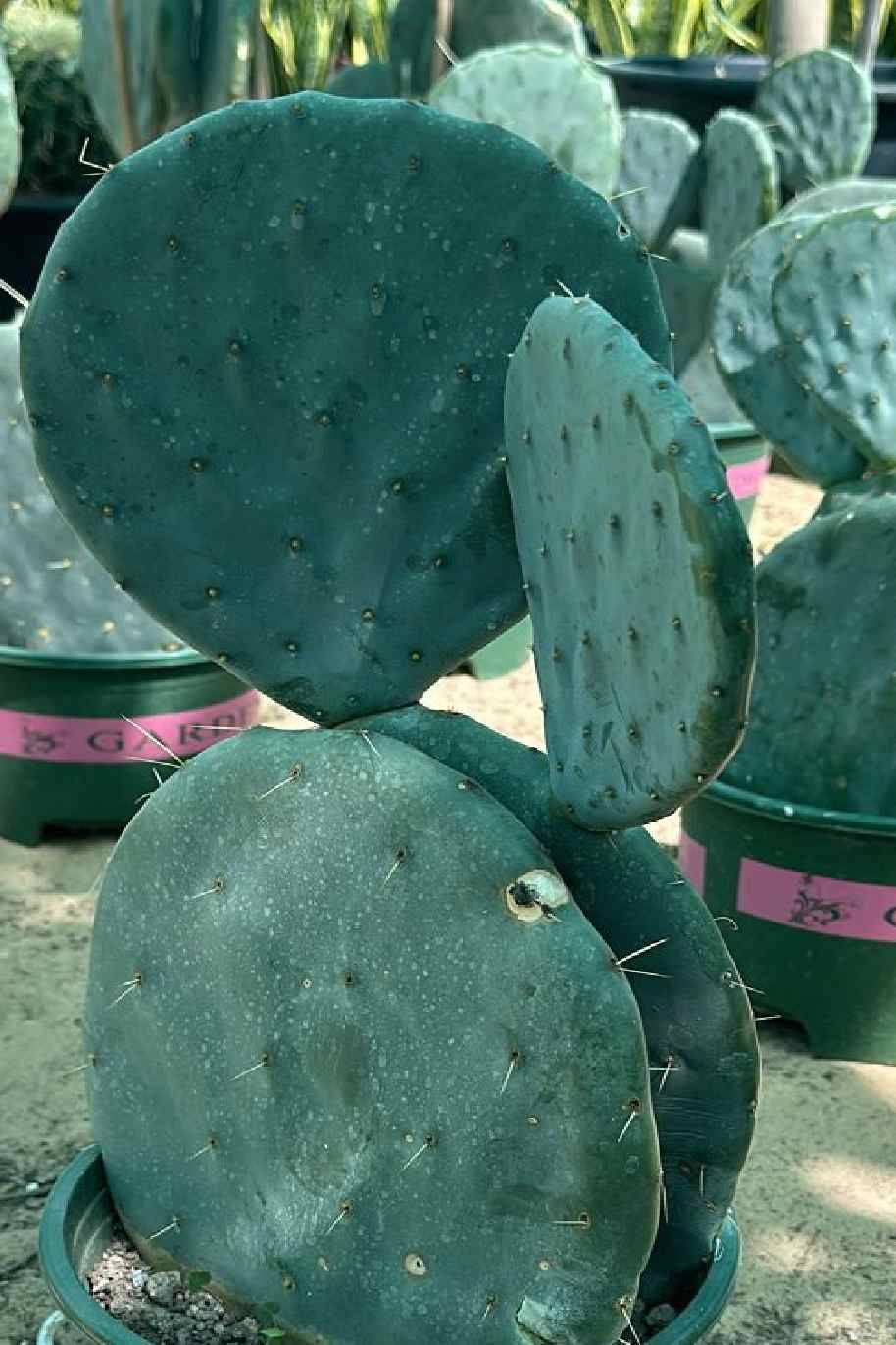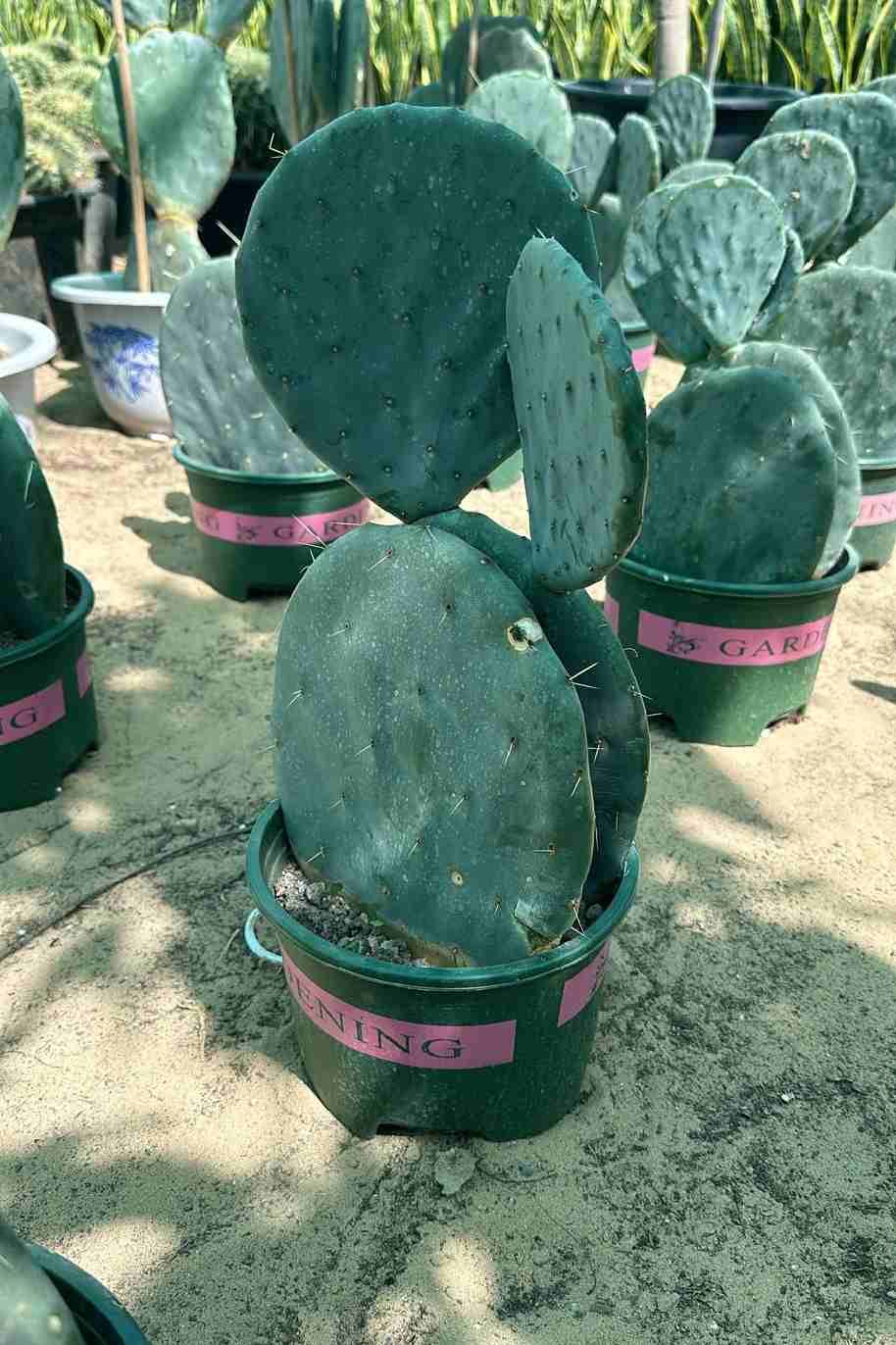Plant Bio
Opuntia robusta, commonly known as the Robusta Prickly Pear or Wheel Cactus, is a species of cactus native to Mexico. It belongs to the Cactaceae family and is renowned for its large, flat pads adorned with spines and vibrant flowers. Here's a description:
Pads: Opuntia robusta features flattened, oval to round pads that are typically bluish-green in color. These pads, also known as cladodes or nopales, can grow quite large, reaching lengths of up to 2 feet (60 centimeters) and widths of 6 to 8 inches (15 to 20 centimeters). They are covered with clusters of sharp spines, which can vary in color from yellow to red or brown.
Spines: The spines of Opuntia robusta are arranged in groups or clusters along the margins of the pads. They serve as both a defense mechanism against herbivores and as a means of reducing water loss through transpiration. While the spines are the primary form of defense, the plant's pads also contain tiny, hair-like glochids that can cause skin irritation upon contact.
Flowers: In late spring to early summer, Opuntia robusta produces stunning, saucer-shaped flowers in shades of yellow, orange, or red. The flowers emerge from the edges of the pads and are typically large and showy, attracting pollinators such as bees, butterflies, and hummingbirds. After flowering, the plant may produce edible fruits known as prickly pears or tunas.
Habitat: Opuntia robusta is well-adapted to arid and semi-arid environments, where it thrives in sandy, rocky soils with good drainage. It is commonly found growing in desert landscapes, rocky hillsides, and along roadsides throughout its native range.
Care Guide for Opuntia robusta:
Light:
Provide Opuntia robusta with full sun exposure to promote healthy growth and flowering. Place the plant in a location where it can receive at least 6 to 8 hours of direct sunlight per day, either outdoors in a sunny spot or near a south- or west-facing window indoors.
Temperature:
Opuntia robusta is highly tolerant of hot, dry conditions and can withstand high temperatures up to 100°F (38°C) or more. It is also moderately cold-hardy and can tolerate brief periods of frost or temperatures down to 20°F (-6°C) when established. Protect the plant from prolonged exposure to freezing temperatures, as it may cause damage or kill the pads.
Soil:
Plant Opuntia robusta in well-draining soil with a sandy or gravelly texture to mimic its native habitat. A cactus or succulent potting mix amended with perlite, coarse sand, or pumice works well. Ensure the soil is porous and does not retain excess moisture, as soggy conditions can lead to root rot.
Watering:
Water Opuntia robusta sparingly, allowing the soil to dry out between waterings. In spring and summer, water the plant thoroughly when the top inch (2.5 centimeters) of soil feels dry to the touch, and reduce watering frequency in fall and winter when growth slows down. Avoid overwatering, as it can cause root rot and other problems.
Fertilization:
Opuntia robusta is relatively low-maintenance and does not require regular fertilization. If desired, feed the plant with a balanced, water-soluble fertilizer diluted to half-strength every 4 to 6 weeks during the growing season (spring through early fall). Alternatively, use a specialized cactus fertilizer formulated for succulents.
Pruning:
Prune Opuntia robusta sparingly to remove any dead, damaged, or diseased pads, as well as any unwanted growth. Use caution when handling the plant, as the spines and glochids can cause skin irritation. Wear thick gloves and use long-handled pruning shears to avoid injury.
Propagation:
Propagate Opuntia robusta from stem cuttings or pads taken from mature plants. Allow the cuttings or pads to callus over for a few days to prevent rot, then plant them in well-draining soil and water sparingly until roots develop. Place the cuttings in a bright, warm location and avoid direct sunlight until they establish roots.
Pest and Disease Control:
Opuntia robusta is relatively resistant to pests and diseases when grown under the right conditions. However, it may occasionally attract aphids, scale insects, or mealybugs, especially if stressed. Treat any pest infestations promptly with insecticidal soap or neem oil. Avoid overwatering, as it can lead to root rot and fungal diseases.
With its unique appearance, drought tolerance, and low-maintenance care requirements, Opuntia robusta is an excellent choice for desert and xeriscape gardens, rockeries, and container cultivation. Follow these care guidelines to ensure your Robusta Prickly Pear thrives and remains healthy for years to come. Adjust care practices based on your specific growing conditions and the needs of the plant.









